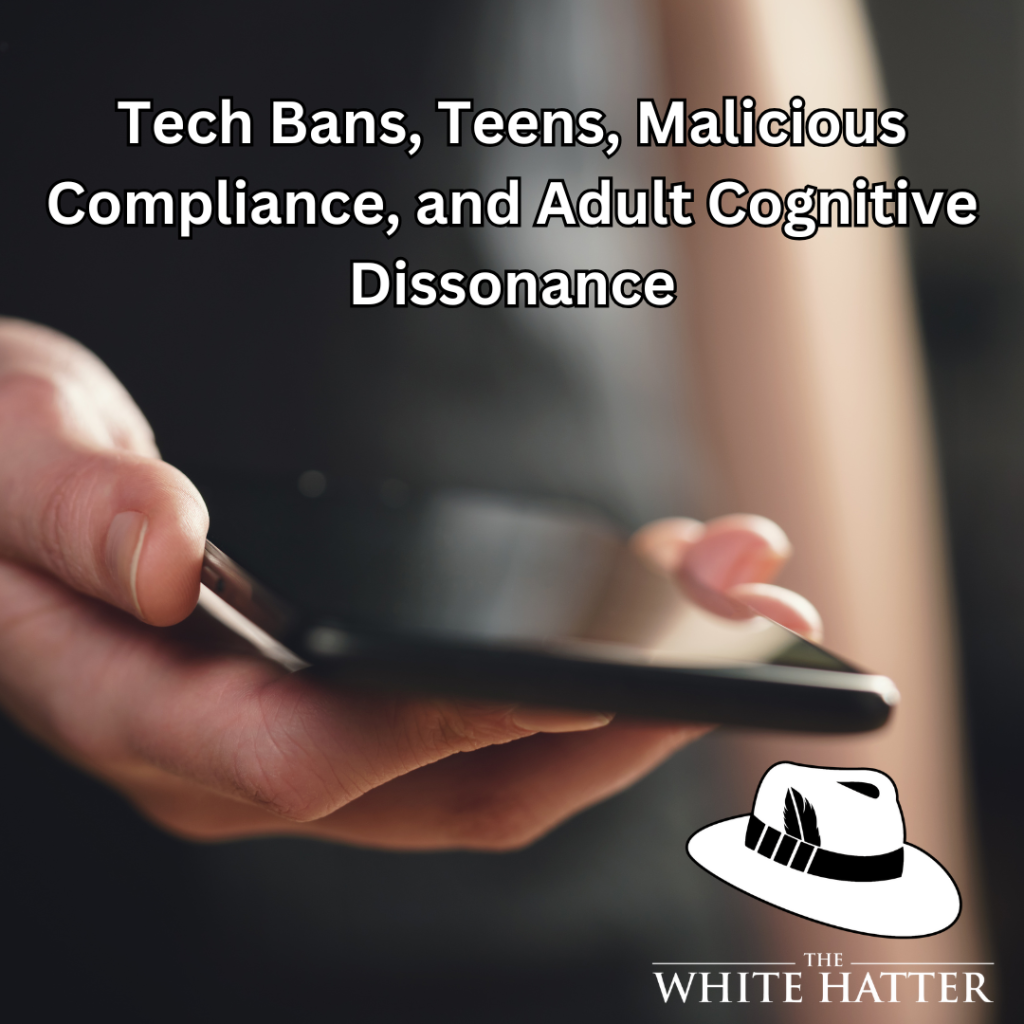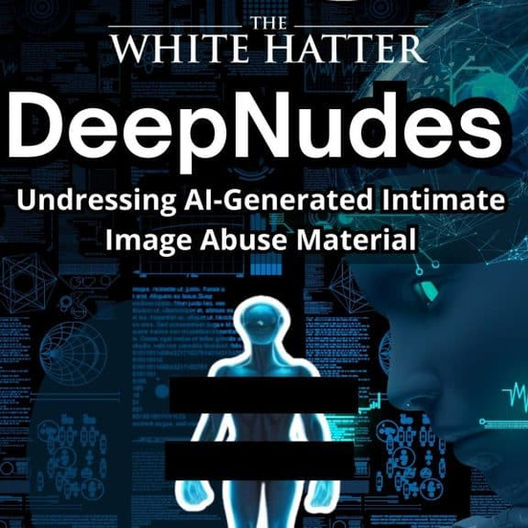Tech Bans, Teens, Malicious Compliance, and Adult Cognitive Dissonance
- The White Hatter

- Oct 16, 2024
- 6 min read
Updated: May 8

Malicious compliance, often described as passive resistance, occurs when someone follows the rules to the letter while knowingly undermining the spirit of those rules. In today’s onlife world, “some” teens are becoming skilled at this, using technology as a tool to push back against tech rules set by parents, caregivers, and schools. This behavior not only highlights their technological savviness but also generates cognitive dissonance in adults, who struggle to reconcile the fact that youth and teens are technically following the rules while still defying their intentions.
Teen malicious compliance is nothing new, in the 1980’s it was common in high school to push back against school dress codes. If a school banned certain items of clothing like band T-shirts or jeans with holes, students might follow the letter of the dress code by wearing the clothing technically allowed, but in exaggerated or mocking ways. For instance, some students would wear oversized, outlandish outfits that were technically "dress code compliant," yet clearly intended to push the boundaries
Malicious compliance involves adhering to the exact wording of a rule or instruction while deliberately subverting its purpose. It allows someone to claim innocence while knowingly and willfully flouting the true intent of the rule. For today’s tech-savvy teens, this form of rebellion has evolved into a digital art, using phones, apps, and online platforms to challenge authority without openly disobeying.
Examples of Teen Malicious Compliance with Technology
Home Rule: No internet use after a certain time.
Malicious Compliance: Teens disconnect from the internet as instructed, but use downloaded videos, games, or podcasts to stay entertained offline, technically avoiding the internet while still using their devices.
Home Rule: Don't use certain apps like Instagram or TikTok.
Malicious Compliance: Teens follow the rule by not using the app itself but access the web-based versions through their browser, using the same platforms but bypassing the app restrictions.
Home Rule: Share your real-time location with parents for safety reasons.
Malicious Compliance: Teens enable location sharing but leave their phone at a friend’s house or a safe location while going elsewhere, technically following the rule but misleading parents about their actual whereabouts.
School Rule: Don’t visit restricted websites on school Wi-Fi or home internet.
Malicious Compliance: Teens avoid directly accessing blocked websites, but use VPNs or proxy servers to bypass the filters and visit restricted content without violating the letter of the rule.
School Rule: Complete and submit a digital assignment as required.
Malicious Compliance: Teens submit an assignment electronically on time, but insert intentional formatting errors, broken links, or corrupted files that “accidentally” prevent the teacher from being able to review the work immediately. They technically followed the submission rule but delayed the grading process.
School Rule: Lock your phone in the Yondr pouch at the start of the school day.
Malicious Compliance: Students comply by placing one phone in the pouch but secretly bring a second burner phone that isn’t locked away, allowing them to continue texting or browsing without breaking the rule on their "official" phone.
School Rule: Lock your phone away in the Yondr pouch.
Malicious Compliance: Students follow the rule by locking away their phones, but they still receive messages, notifications, and updates on their smartwatch or laptop, continuing to engage with their devices without accessing their phones.
Adults who set these rules, whether they are parents, teachers, or school administrators, often experience cognitive dissonance when teens engage in malicious compliance. Cognitive dissonance occurs when someone holds two conflicting beliefs or values, leading to psychological discomfort.
As an example - some parents and caregivers believe that excessive use of smartphones or social media is harmful to their child's mental and emotional well-being (one belief). At the same time, they might allow or even encourage the use of these devices because of the convenience it brings in terms of entertainment, communication, or educational resources (conflicting action). This inconsistency can create tension as parents and caregivers struggle between wanting to limit screen time and relying on technology to manage their child’s daily activities.
An example of how this cognitive dissonance might manifest could be a parent or caregiver who feels strongly about the dangers of social media for their child's mental health but continues to let the child use platforms like Instagram or TikTok to avoid conflict, peer pressure, or because it helps the child stay connected with friends. This unresolved tension can lead to stress or discomfort as the parent or caregiver tries to reconcile these conflicting attitudes and behaviors.
A school example - a teacher might believe that technology can be a powerful tool to enhance learning (one belief), especially when used for research, collaboration, or accessing educational resources. However, they may also feel that students often misuse technology during class for distractions like social media, texting, or gaming (conflicting belief). This conflict between seeing technology as both a valuable educational resource and a source of distraction creates cognitive dissonance.
A teacher may encourage students to use their laptops or tablets for taking notes or researching class-related topics. Yet, during the lesson, the teacher notices that some students are also checking social media or playing games. The teacher experiences psychological discomfort because they support the integration of technology into the classroom for learning but are frustrated by how students misuse it. This process allows the teacher to reconcile their conflicting beliefs about technology's benefits and drawbacks in education.
Parents, caregivers, and teachers feel the rules surrounding technology should work, but when they don’t, it forces them to reconsider the effectiveness of their authority or the way rules are framed. This discomfort is further amplified by the technological divide between adults and teens, where adults may feel outmaneuvered by their children's skillful use of digital tools.
When faced with cognitive dissonance, adults often respond in one of two ways:
1/ Some may attempt to reinforce the rules, adding layers of restrictions or increasing punishments. This can result in a vicious cycle where teens find new loopholes and adults impose even stricter rules, further intensifying the dissonance.
2/ Others may recognize that the rules need to change. Instead of focusing on strict adherence, they may shift toward creating rules that account for the teens’ autonomy while emphasizing the reasoning behind the boundaries. This approach encourages a more collaborative relationship where trust and open communication can reduce the need for teens to engage in malicious compliance.
To effectively address issues of malicious compliance and cognitive dissonance, when it comes to technology, we believe it is vital for adults to clearly explain the rationale behind rules. When teens understand why a rule exists and what outcomes are expected, they are more likely to adhere to it in spirit rather than merely following it in the letter.
Simply stating that "this is how it is" often falls short and is always followed by the question – “why?”. We need to be able to answer the why, rather than just saying, “just because”. Additionally, adults should enhance their understanding of how teens use technology. By keeping up with current apps, platforms, and potential workarounds, they can create more tech-aware boundaries that reflect both the letter and the spirit of the rules.
Open communication between adults and teens plays a crucial role in bridging the gap. Rather than enforcing rules unilaterally, engaging in discussions about expectations, technology use, and independence helps both parties align on what constitutes genuine compliance. Involving youth in drafting the actual rules fosters a sense of ownership and cooperation. Moreover, instead of relying solely on rules, adults should focus on teaching teens how to manage their time and responsibilities in the presence of technology. A digital literacy approach reduces the likelihood of teens exploiting loopholes, as they will better understand the larger context of why limits are established.
The concept of malicious compliance demonstrates how teens, by exploiting loopholes in rules, can challenge the authority of parents and educators without explicitly disobeying. This clever use of technology not only showcases their digital skill set but also brings about cognitive dissonance in adults who struggle to maintain control.
To resolve this dissonance, adults must rethink how they enforce rules, either by reinforcing stricter limitations or shifting toward collaborative, trust-based relationships that incorporate teen autonomy. By explaining the reasoning behind rules, staying informed about evolving tech trends, and fostering open dialogue, adults can create environments where teens are more likely to genuinely respect boundaries, ultimately reducing the need for malicious compliance.
Teen’s use of malicious compliance through technology is a modern-day reflection of their desire for autonomy and use of digital tools in today’s onlife world. While it can be frustrating for adults, it also forces a re-evaluation of how rules are made and enforced. The cognitive dissonance created by these situations challenges adults to rethink the way they handle authority in today’s onlife world. By acknowledging this dissonance and adjusting approaches accordingly, parents and educators can foster a more effective and trusting relationship with teens - one that respects their independence while guiding them toward responsible technology use within boundaries.
Digital Food For Thought
The White Hatter
Facts Not Fear, Facts Not Emotions, Enlighten Not Frighten, Know Tech Not No Tech














